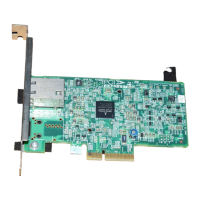PHY ControlBCM5718 Programmer’s Guide
Broadcom®
January 29, 2016 • 5718-PG108-R Page 64
The specifics of MII may be located in section 22 of the IEEE 802.3 specification. RXD[3:0] are the receive data
signals; TXD[3:0] are the transmit data signals. MII operates at both 10-Mbps and 100-Mbps wire-speeds.
(Gigabit Ethernet uses the GMII standard.) When MAC and PHY are configured for 10 Mbps operation, the
RX_CLK1 and MII_TXCLK clocks run at 2.5 MHz. Both RX_CLK1 and MII_TXCLK are sourced by the PHY. 100
Mbps wire speed requires RX_CLK1 and MII_TXCLK to provide a 25 MHz reference clock. Receive Data Valid
(RX_DV) is asserted when valid frame data is received; at any point during data reception, the PHY may assert
Receive Error (RX_ER) to indicate a receive error. The MAC will record this error in the statistics block. The
MAC may discard a bad RX frame—exception being sniffer/promiscuous modes (see Allow_Bad_Frames bit in
MAC mode register). The Transmit Enable (TX_EN) signal is asserted when the MAC presents the PHY with a
valid frame for transmission. The MAC may assert TX_ER to indicate the remaining portion of frame is bad. The
PHY will insert Bad Code symbols into the remaining portion of the frame. A detected collision in half-duplex
mode may be such a scenario where TX_ER is asserted. The PHY will assert COL when a collision is detected.
The COL signal is routed to both the RX and TX MACs. The transmit MAC will back off transmission and the
RX MAC will throw away partial frames.
The 10 Mbps physical layer uses Differential Manchester encoding on the wire. Manchester encoding uses two
encoding levels: 0 and 1. 100 Mbps Ethernet requires MLT-3 waveshaping on the transmission media. MLT-3
uses three encoding levels: –1, 0, and 1. Both physical signaling protocols are transparent to the MAC sublayer
and are digitized by the PHY. The PHY encodes/decodes analog waveforms at its lower edge while the PHY
presents digital data at its upper edge (MII).
GMII Block
The GMII is full-duplex (see Figure 9 on page 65); the send and receive data paths operate independently.
The transmit signals TXD[7:0] create a eight-bit wide data path. The TXD[7:0] signals are synchronized to the
reference clockTX_CLK0. The TX_CLK0 clock runs at 125 MHz and is sourced by the MAC sublayer. Transmit
Error (TX_ER) is asserted by the MAC sublayer. The PHY will transmit a bad code until TX_ER is deasserted
by the MAC. TX_ER is driven synchronously with TX_CLK0. The Transmit Enable (TX_EN) indicates that valid
data is presented on the TXD lines. The TXD[7:0] data is framed on the rising edge of TX_EN.
The receive data path is also eight bits wide. RXD[7:0] are sourced by the PHY. When valid data is presented
to the MAC sublayer, the PHY will also assert Receive Data Valid (RX_DV). The rising edge of RX_DV indicates
the beginning of a frame sequence. The PHY drives the reference clock RX_CLK1, so the MAC sublayer can
synchronize data sampling on RXD[7:0]. The PHY may assert RX_ER to indicate frame data is invalid; the MAC
sublayer must consider frames in progress incomplete.
When the MAC operates in half-duplex mode, a switch or node may transmit a jamming pattern. The PHY will
drive the Collision (COL) signal so the MAC may back off transmission and throw away partially received
packet(s). The COL signal will also cause the TX MAC to stop the transmission of a packet. The COL signal is
not driven for full-duplex operation since collisions are undefined. The PHY will drive Carrier Sense (CRS) as a
response to traffic being sent/received. The MAC sublayer can monitor traffic and subsequently drive traffic
LEDs.

